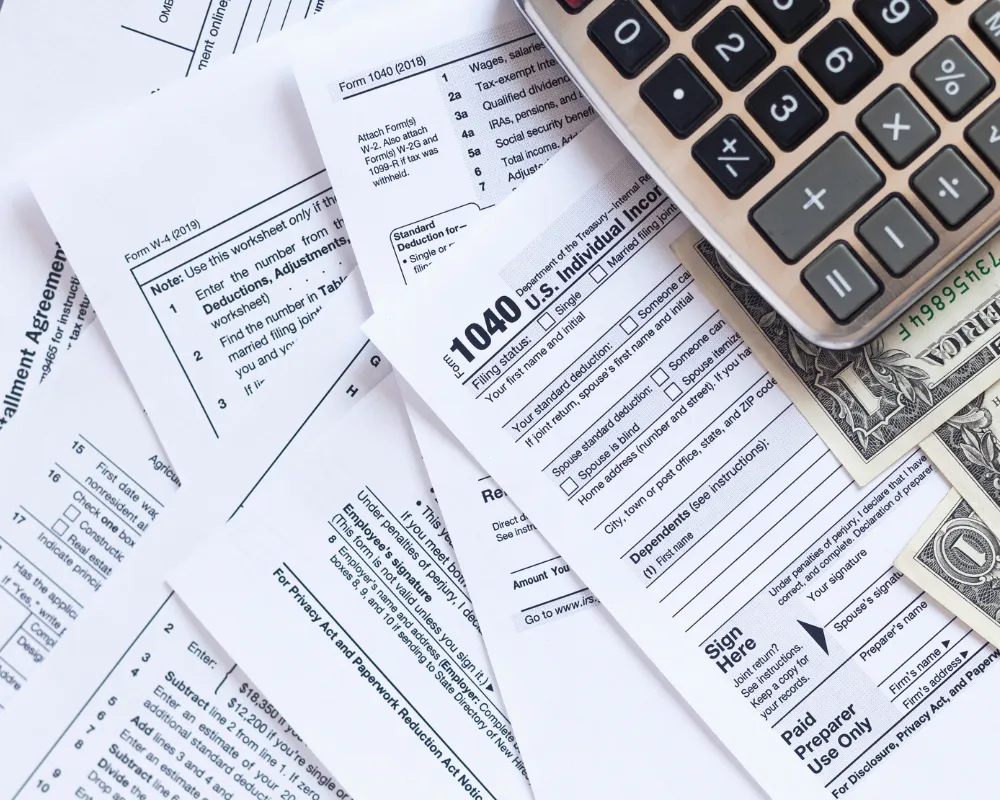
Various tax forms, a calculator and US dollars on a table.
Streamlining Tax Payments and Invoicing: Leveraging Fixed Costs and Modern Solutions for Business Efficiency
Starting a consulting business involves a lot of responsibilities one of which is paying taxes which can be unpleasant. The business income and expenses mustbe utlitized in calculating the tax. For it to be registered in the UK or anywhere else in the world certain standards have to be met. Simplified tax strategies such as charged expenses help a lot in managing taxes better.
What are fixed expenses?
One of the integral parts of a sole proprietorship's activities is income tax, which requires accounting for income and expenses. You then determine your tax base by subtracting your actual expenses from your income. However, especially small businesses with low costs can use so-called fixed costs, also known as interest taxes. Here, you do not deduct your actual expenses from your real income, but a fixed percentage, regardless of the actual amount of expenses. The specific percentages of fixed costs then differ depending on the field of activity.
How much do their fixed costs cost?
Fixed-rate expenses are regulated by the Income Tax Act, which provides a breakdown of individual interest company registration fees in the UK ranging from 30 to 80%. For each rate, there are also limits on the amount of expenses above which the specified percentage can no longer be deducted.
- 80% fixed costs: income from agricultural production, forestry, water management, and handicrafts,
- 60% of fixed costs: income from trade,
- 40% of fixed expenses: other income from self-employment,
- 30% of fixed expenses: income from renting property included in business property.
The Hoxton Mix team would like to note there is an exception for the 40% flat rate in the form of copyright income and income derived from a share of profits in a public business or limited liability company, to which the flat rate cannot be applied.
The types of income mentioned above logically determine the sectors to which these rates apply. They can be found in Annex 1 to the Trade Act and include, for example, the following areas:
- 80% flat rate: farmer, fisherman, butcher, plumber, hairdresser, mechanic, etc.
- 60% flat rate: geologists, opticians, teachers, financial advisors, housing providers, and other self-employed entrepreneurs,
- 40% flat rate: lawyer, notary, architect, artist, etc.
- 30% flat rate: the landlord of an apartment, house, land plot, non-residential premises, or movable property (car, equipment, etc.).
What happens if I exceed the limit?
The maximum amount to which expenses can be applied at a single fixed rate is stipulated by these thresholds. It is important to understand, however, that exceeding these restrictions does not preclude one from applying this flat rate system altogether. So let us say you exceed such a threshold by 60% in respect to lump sum payment (for instance when initial phase of business registration process takes place in UK); then only 60% out of 1.2 million shall be deductible i.e., not the whole amount. Income tax base in such case would mean the difference from the actual income figure and maximum percent cost.
Who will benefit from fixed costs and who will not?
The biggest advantage of percentage taxation is the significantly simplified administration, when it is not necessary to keep accurate records of expenses, but only to record income. If your real expenses are significantly lower than your fixed expenses (or your income is higher), you can achieve significant tax savings compared to using real expenses.
For example, a freelancer (for example, a language teacher) earned 700,000 pounds for the year, and his expenses amounted to only 150,000 pounds. This means that using real expenses, he would use the amount of 550,000 as a tax base, while at a flat rate of 60%, he would be taxed only 280,000 pounds.
The switch from fixed costs to actual costs would then pay off for, for example, a craftsman with an income of £2.5 million and expenses of £1.7 million. According to the actual costs, he would be taxed an amount of 800,000 pounds. If he wanted to use the flat rate, he could only deduct the appropriate 80% of the £1.6 million because the actual expenses exceed the statutory limit. As a result, his tax base would be £900,000.
Make invoicing a strength of your business
As an entrepreneur, you will undoubtedly encounter different types of invoices. Most commonly, invoices are divided into issued (yours, which must be paid by the client) and received (from your suppliers, which you pay).
Both categories include:
- (Regular) invoices: the classic document after an order is completed.
- Advance invoices: if you or your supplier want to receive some money upfront.
- Proforma invoice: a form of advance invoice that is used to pay the full amount.
- Invoices: used to pay advance invoices and proforma invoices.
Some entrepreneurs issue invoices in Excel or find an invoice template online that they transcribe. Modern invoices are issued in invoicing applications:
- fast (takes a few clicks)
- convenient (you can easily issue an invoice from your cell phone on the way home from a meeting)
- following the law (the team of developers and lawyers responds to changes in legislation)
- presentable (invoices look good)
Our Hoxton Mix team offers much more than just the invoicing function. Thanks to them, you will get a perfect overview of cash flows, the applications themselves send customers reminders after the deadline or thank you for payment.
If you work with an accountant, you give her access to your account in the invoicing application, and she uploads all the documents for her work. You have access to all documents 24/7, and they are securely stored. Due to tax audits, you must archive invoices for at least 3 years, even as a VAT non-payer. If you do accounting, archive documents for 10 years.
Conclusion
In conclusion, leveraging fixed costs can streamline tax payments for self-employed individuals, offering a simplified approach to managing income tax obligations. By opting for fixed expenses, entrepreneurs can bypass the need for meticulous expense tracking, relying instead on predetermined percentages based on their field of activity. With secure storage and accessibility, coupled with automated reminders and thank-you messages, these invoicing applications offer entrepreneurs a robust solution for managing their financial affairs effectively.


